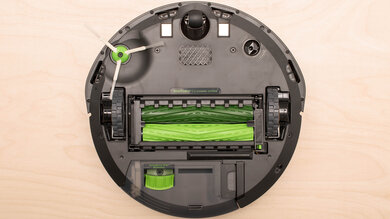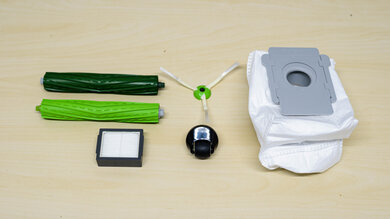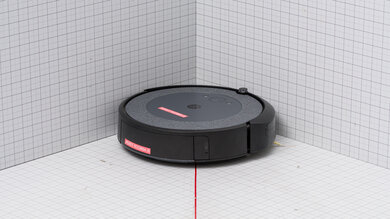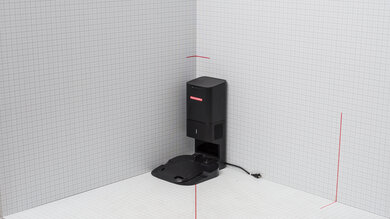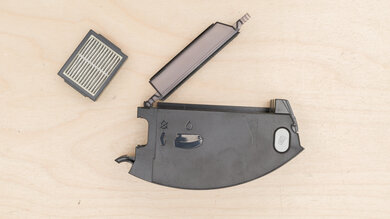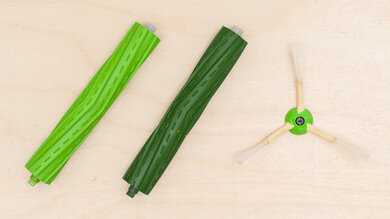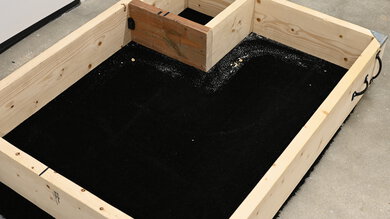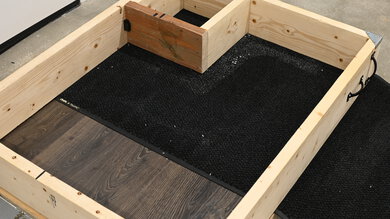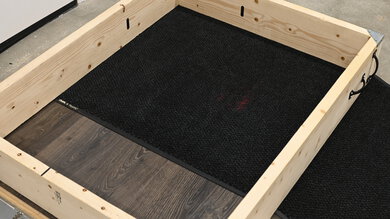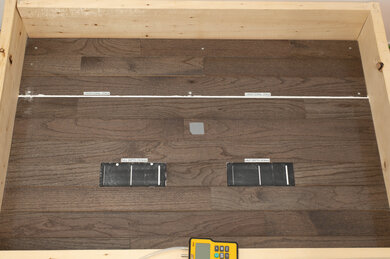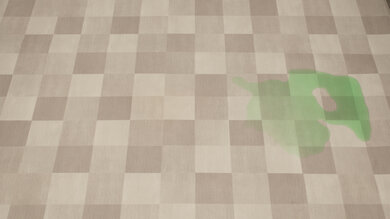The iRobot Roomba i3 is a robot vacuum that sits at the bottom of iRobot's lineup of smart-pathing vacuums. It offers self-emptying capability, automatically emptying debris from its small internal dustbin into a much larger external dirtbag attached to its charging dock. It detects surface types and automatically adjusts its head height and suction. Dust is sealed away with a HEPA filter.
Our Verdict
The iRobot Roomba i3 is alright for bare floors. This vacuum feels very well-built, does a great job maneuvering itself around obstacles, and recharges very quickly. It effectively cleans medium and large debris from bare floors but scatters fine debris and doesn't clean well close to walls and corners. It also incurs high recurring costs.
-
Excellent build quality.
-
Automatically empties dustbin into large external dirtbag.
-
Easily sucks up medium and large debris.
-
High recurring costs and demanding maintenance needs.
The iRobot Roomba i3 is a decent option for vacuuming low-pile carpets. It picks up a good amount of larger debris but struggles with fine material. It also has many parts that need periodic cleaning, and this model incurs high recurring costs. It feels well-built and does a great job of maneuvering itself.
-
Excellent build quality.
-
Automatically empties dustbin into large external dirtbag.
-
High recurring costs and demanding maintenance needs.
-
Struggles with fine debris.
The iRobot Roomba i3 is a satisfactory choice for high-pile carpets. It can climb onto these sorts of surfaces thanks to its self-adjusting cleaning head height and automatically increases its suction power on carpeted floors. It does an alright job of clearing larger debris, but it has a very hard time sucking up especially fine debris. It incurs high recurring costs and has many parts that need regular cleaning.
-
Excellent build quality.
-
Automatically empties dustbin into large external dirtbag.
-
Automatic surface type adjustment feature.
-
High recurring costs and demanding maintenance needs.
-
Struggles with fine debris.
The iRobot Roomba i3 is an alright choice for cleaning pet hair. This vacuum does a good job of clearing pet hair from low-pile carpet and uses a removable brushroll, making it easier to clear any tangled material. It also has an allergen-trapping HEPA filter. However, it has many parts that need periodic cleaning, and this model incurs high recurring costs.
-
Equipped with an allergen-trapping HEPA filter.
-
Effective at cleaning pet hair.
-
High recurring costs and demanding maintenance needs.
- 6.5 Bare Floor
- 7.0 Low-Pile Carpet
- 7.1 High-Pile Carpet
- 6.5 Pets
-
Updated Feb 11, 2025:
We've rewritten this review to bring it up to date and made minor text adjustments.
- Updated Sep 20, 2024: We've added text to this review for the new tests added in Test Bench 0.8.
- Updated Aug 26, 2024: We've updated the scores in the Hard Floor Pick-Up, High-Pile Carpet Pick-Up, Low-Pile Carpet Pick-Up, and Pet-Hair Pick-Up tests to align with a broader data set. For more information about the reasoning for this update, you can look at our forum post.
- Updated Jul 23, 2024: Converted to Test Bench 0.8.
- Updated May 24, 2024: We've added a link to the Shark Matrix Plus in the 'Maneuverability' section of the review to provide an alternative with a LIDAR mapping sensor.
- Updated Dec 14, 2023: Converted to Test Bench 0.7.
- Updated Jan 12, 2023: We've changed the full product name to 'iRobot Roomba i3' in order for the review to encompass all model variants.
- Updated Nov 11, 2022: A recent firmware update lets you use the vacuum's companion app to create room dividers and select distinct cleaning settings for different rooms. We've updated the score and text in the 'Companion App Automation' to reflect these updates.
- Updated Nov 02, 2022: Included a link to the iRobot Roomba i8+ in the 'Companion App Automation' section to provide an alternative that offers support for virtual boundary markers.
- Updated Jul 29, 2022: Converted to Test Bench 0.6.
- Updated May 27, 2022: Converted to Test Bench 0.5.
- Updated Jan 24, 2022: Updated review for accuracy and clarity.
- Updated Apr 19, 2021: Corrected input error in 'Power Adjustment' field of 'Quality of Life Features' section.
- Updated Feb 03, 2021: Review published.
- Updated Jan 28, 2021: Early access published.
- Updated Jan 19, 2021: Our testers have started testing this product.
- Updated Jan 15, 2021: The product has arrived in our lab, and our testers will start evaluating it soon.
- Updated Jan 11, 2021: We've purchased the product and are waiting for it to arrive in our lab.
Check Price
Differences Between Sizes And Variants
The iRobot i3 has two primary variants. The model without the automatic dirt disposal feature is sold as the iRobot Roomba i3 EVO 3150, while the self-emptying variant we tested is known as the iRobot Roomba i3+ EVO 3550. Both vacuums are mechanically identical, with the sole exception of the i3 Plus having a slightly different internal dustbin, which features a debris disposal port covered by a rubber flap. You can buy a basic i3 and purchase the self-emptying docking station later, which also includes the redesigned internal dustbin. Regardless, both models will deliver similar overall cleaning performance, though the inclusion of the auto-empty dock does reduce hands-on maintenance requirements.
Either variant is only available in one color scheme: 'Woven Neutral,' featuring a simulated gray fabric ring around darker gray plastic. You can see the label of our test unit here.
If you come across a different variant of this vacuum, please let us know in the comments, and we'll update our review.
Compared To Other Robot Vacuums
The iRobot i3+ is a robot vacuum with an automatic dirt disposal feature. Like the i7+ variant of the iRobot Roomba i7, it automatically empties its small internal dustbin into a much larger dirtbag contained in its docking station. While it is cheaper than the i7, it has less sophisticated mapping and fewer automation features in the app, though it performs similarly.
If you're looking for more options, see our lists of the& best robot vacuums, the best robotic vacuums for hardwood floors, and the best robot vacuums for pet hair.
The Shark IQ Robot is a better-performing vacuum than the iRobot Roomba i3. The Shark picks up more pet hair from bare floors and has a better performance on low- and high-pile carpets. It also has fewer recurring costs. On the other hand, the iRobot is better built and has an automatic dirt disposal feature.
The iRobot Roomba i3 is a better vacuum than the iRobot Roomba E5 for most uses. The i3 has a significantly better performance on bare floors and picks up more debris from high-pile carpets. It's also better at maneuvering itself and has an automatic dirt disposal feature. On the other hand, the E5 clears more pet hair from carpets and has a slightly longer battery life.
The iRobot Roomba i4 is a better robot vacuum than the iRobot Roomba i3. The i4 has a better cleaning performance on low and high-pile carpet. Since it doesn't have an external dirtbag, it has fewer recurring costs. Also, it comes with a Dual Virtual Barrier Device, which lets you mark areas for the vacuum to avoid while cleaning. That said, the i3 does a better job of cleaning bare floors, and it has a larger dirt compartment. Also, it comes with an external dustbin attached to the docking station, so it can automatically empty its dirt compartment.
The iRobot Roomba i3 is a little better than the iRobot Roomba i1, though it's worth mentioning that the two vacuums are mechanically identical, with the i1 being a retailer-specific variant of the i3. Following a firmware update, the i3 received support for imprint smart mapping, which allows you to set up virtual boundary lines or label specific rooms.
The Wyze Robot Vacuum is better than the iRobot Roomba i3. The Wyze has fewer parts requiring regular maintenance, incurs lower recurring costs, lasts longer on a single charge, and delivers better performance on bare floors and carpets. However, the iRobot does have an automatic surface adjustment feature and a self-emptying function that reduces hands-on maintenance requirements.
The iRobot Roomba 960 is slightly better than the iRobot Roomba i3. The 960 incurs lower recurring costs, is more effective on low-pile carpet, does a better job dealing with pet hair, and can climb over obstructions like rug tassels with less difficulty. It also comes with a virtual wall tool that generates a barrier that the vacuum won't cross. However, the i3 does have a self-emptying function that reduces hands-on maintenance requirements since it can automatically transfer debris from its internal dirt compartment to an external dustbin attached to its charging dock.
The iRobot Roomba 981 is better than the iRobot Roomba i3. The 981 incurs lower recurring costs, maneuvers over obstacles like electrical cords more easily, and delivers superior cleaning performance on bare floors and low-pile carpet, especially with pet hair. Meanwhile, the i3 has a more advanced set of automation features, most prominently its self-emptying function, which lets it dump any accumulated debris into an external dustbin mounted to its charging dock.
The yeedi vac station is better than the iRobot Roomba i3 for most uses. The yeedi has fewer parts that require regular cleaning, incurs lower recurring costs, maneuvers itself more effectively, and clears notably more debris on carpeted floors. It also has a much longer maximum battery life, though the iRobot does take much less time to recharge. The iRobot also has a slightly larger external dirt compartment, has a HEPA filter to trap allergens as it cleans, and is a little easier to store.
The iRobot Roomba i3 and the Shark EZ Robot Self-Empty each have advantages, meaning one may suit you better than the other, depending on your needs. The iRobot has a larger external dustbin mounted to its base station, feels better built, has fewer parts that require periodic maintenance, maneuvers itself more effectively, and delivers superior performance on bare floors. It also charges much faster, though it doesn't last as long as the Shark on a single charge. The Shark also outperforms the iRobot on carpeted floors, especially with pet hair, and incurs fewer recurring costs.
The Roborock S7 is better than the iRobot Roomba i3. The Roborock feels better built, has fewer parts requiring regular cleaning, incurs lower recurring costs, comes with a mopping attachment for tackling messes on bare floors, has a longer battery life, and performs better on bare floors as well as low- and high-pile carpets. It also has a more advanced mapping system that lets you schedule cleaning jobs for specific areas or set up virtual boundary lines. Conversely, the i3 charges much faster. The i3 also has a self-emptying function that allows it to automatically dump debris from its internal dirt compartment to an external dustbin attached to its charging dock. However, a similar feature is available for the Roborock for an additional cost.
The Roborock S6 MaxV is better for most purposes than the iRobot Roomba i3. The two models deliver a fairly similar performance on bare floors and carpets, but the Roborock is better built, easier to maintain, and incurs fewer recurring costs. On the other hand, the iRobot has an automatic dirt disposal feature, so you shouldn't need to worry about emptying its small internal dustbin.
The iRobot Roomba j7 is better than the iRobot Roomba i3. The j7 has a longer battery life, maneuvers itself slightly more effectively, is able to identify and react to hazards in real time, clears more debris on bare floors, and feels slightly better built. The i3 charges faster, however.
The eufy RoboVac X8 is better for most uses than the iRobot Roomba i3. The eufy incurs lower recurring costs, has a much longer battery life, and performs better across all surface types. However, the iRobot does have a self-emptying feature, which allows it to dump any accumulated debris from its internal dustbin into an external dirt compartment on its charging dock. It also does a better job of maneuvering itself, feels better built, has an onboard HEPA filter, and charges much faster.
The Neato D8 is better than the iRobot Roomba i3. The Neato has fewer parts that need regular cleaning, incurs lower recurring costs, and delivers better performance on bare floors and carpets. However, the iRobot has an automatic surface adjustment feature and does a better job of climbing over rug tassels and power cords. This variant of the i3 also has a self-emptying feature, which allows it to dump debris from its internal dustbin into an external dirt compartment attached to its charging dock.
The Roborock S7 MaxV is better than the iRobot Roomba i3, though this isn't surprising given the significant price gap between the two. The Roborock feels better built, has a mopping function to scrub away stains, and does a better job of sucking up debris on all surface types. Its dual-sensor navigation system plots out its coverage area in precise detail and allows it to identify and react to hazards in real-time. While the iRobot does come bundled with a self-emptying station at a much more affordable price point than the Roborock, the latter's optional Empty Wash Fill Dock is substantially more advanced, as it not only empties debris from its internal dustbin but also refills its water reservoir and cleans its mop pads.
The iRobot Roomba i8+ is better than the iRobot Roomba i3. The i8+ has a longer overall battery life, delivers superior performance on bare floors as well as carpets, and does a better job of maneuvering itself.
The iRobot Roomba i3 is better for most purposes than the Shark IQ Robot AV992 Series. The Roomba is better built and has more advanced automation features. It has an automatic dirt disposal feature, so you shouldn't need to empty its small internal dustbin, and it does a much better job of maneuvering itself. On the other hand, the Shark does a significantly better job cleaning bare floors and low-pile carpeting.
The Roborock S6 is better than the iRobot Roomba i3. The Roborock is better built, is less demanding in maintenance, incurs fewer recurring costs, maneuvers over obstructions like electrical cords with less difficulty, and delivers notably superior performance on bare floors and low-pile carpets. It also comes with a mopping attachment, though we don't currently test that feature. Meanwhile, the iRobot features an automatic dirt disposal function, as it can empty its internal dustbin into an external dirt compartment built into its charging dock. It also charges faster than the Roborock, though its maximum runtime is much shorter.
The iRobot Roomba i3 is better than the iRobot Roomba 694. The i3 can empty its internal dustbin into an external dirt compartment attached to its charging dock. It also has a smart pathing feature, yielding superior maneuverability and allowing you to check a map of its cleaning coverage or schedule cleaning sessions in advance. The i3 also delivers better performance on all surface types. Meanwhile, the 694 has a longer battery life, though this can vary in the real world.
The Ecovacs DEEBOT OZMO T8 AIVI is better for most uses than the iRobot Roomba i3. The Ecovacs feels better built, incurs lower recurring costs, has a mopping attachment for clearing messes on bare floors, does a better job of cleaning pet hair on most surface types, and has a longer battery life, though the iRobot does charge much faster. The Ecovacs also has a more sophisticated mapping and navigation system, with a combination of LIDAR and optical sensors, allowing it to spot and react to hazards in real-time. However, the iRobot has fewer parts that need regular cleaning. This variant of the iRobot i3 also has a self-emptying feature, which allows it to dump debris from its internal dustbin into an external dirt compartment attached to its charging dock, reducing hands-on maintenance requirements.
The iRobot Roomba i3 is a better vacuum than the Shark AI Robot. They perform fairly similarly overall, but the iRobot does a much better job on bare surfaces and high-pile carpets. It's also better built and has an automatic dirt disposal feature. On the other hand, the Shark has a better performance on low-pile carpets and lower recurring costs.
The iRobot Roomba i3 is better than the Shark ION Robot AV753 Series. The iRobot feels better built, has fewer parts requiring regular maintenance, comes with an allergen-trapping HEPA filter, maneuvers itself more effectively, and performs better on all surface types. It also has a far more advanced suite of automation features, most notably its self-emptying feature, which allows it to dump any accumulated debris into a larger dirtbin built onto its charging dock. It's also capable of resuming an in-progress cleaning session after returning to its dock to recharge. Conversely, the Shark is easier to store, incurs lower recurring costs, and has a much longer battery life, though the iRobot charges a lot faster.
The iRobot Roomba S9 is better than the iRobot Roomba i3. The S9 is better built, incurs fewer recurring costs, has a longer battery life, maneuvers itself more effectively, and performs better on all surface types. Meanwhile, the i3 has a self-emptying function, though it's worth noting that this feature is also available for the S9 at an additional cost.
The Roborock E4 is better than the iRobot Roomba i3. The Roborock has fewer parts requiring regular cleaning, incurs lower recurring costs, and delivers notably better performance on bare floors and low-pile carpets, especially with pet hair. It also has a longer battery life than the iRobot, though the Roborock takes much longer to recharge. The iRobot, meanwhile, has a self-emptying function that allows it to dump debris from its internal dustbin into an external dirt compartment on its charging dock.
The iRobot Roomba i3 is better than the eufy RoboVac G30. The iRobot feels better built, charges significantly faster, maneuvers itself more effectively, has a HEPA filter, and delivers better performance across all floor types. It also has more advanced automation capabilities, with a self-emptying feature that enables it to dump debris from its internal dustbin into an external dirt compartment attached to its charging dock. It can also resume a cleaning job from where it left off if it had to recharge partway through the session. Conversely, the eufy incurs lower recurring costs.
The iRobot Roomba i3 is a better-performing robot vacuum than the iRobot Roomba 675. The i3 delivers better performance on all surface types and uses smart pathing to maneuver itself more efficiently. It also has an automatic dirt disposal feature. Nevertheless, the 675 has a longer battery life and is more portable because it has a carrying handle.
The iRobot Roomba i3 is better than the eufy RoboVac 30C. The iRobot feels better-built, has fewer parts that need regular cleaning, charges much faster, does a better job of maneuvering itself, and delivers better performance on all surface types. It also has far more sophisticated automation features, most notably its self-emptying function that allows it to dump debris from its internal dustbin into an external dirt compartment on its charging dock, reducing hands-on maintenance requirements. However, the eufy incurs lower recurring costs.
The iRobot Roomba i3 is a much better robot vacuum than the eufy RoboVac 11S. The iRobot feels better built, has fewer parts that need regular cleaning, has a HEPA filter, charges much faster while offering similar overall battery performance, and is more effective in clearing debris on bare floors and high-pile carpets. The iRobot also does a better job of maneuvering itself and has more advanced automation features, most notably its self-emptying capability that lets it automatically transfer debris from its internal dirt compartment to an external dustbin attached to its charging dock. That said, the eufy delivers better pet hair-cleaning performance on carpets and incurs lower recurring costs.
The iRobot Roomba i7 is a slightly better vacuum than the iRobot Roomba i3. The i7 has better sensors and more automation choices in the app, but these two models perform pretty similarly.
Test Results
The iRobot Roomba i3 3550 feels impressively well-built. Its body is made of sturdy plastic, and its rubber wheels feel durable. While the top cover looks like it's lined with woven fabric, it's actually textured plastic. However, its internal dustbin feels somewhat fragile. There are three buttons on top of the robot: a big center one to start and stop a cleaning cycle and two smaller buttons to send the vacuum home and have it spot-clean an area.
The vacuum comes pre-assembled, so all you need to do is set up the docking station, which arrives with a dirtbag already inside.
The iRobot i3 has many parts that need to be removed and serviced regularly, but fortunately, they're all easy to access. The user manual explains things in much greater detail.
If you have the i3 non-Plus variant without the dirt-collecting docking station, you should empty the dustbin after each vacuuming. If necessary, you can wash it with water, but be sure to remove the filter beforehand.
The filter is located inside the dustbin. Clean it once a week, or twice a week in homes with pets. Don't wash it with water.
The two brushrolls are easy to access. You can remove any tangled hair or stuck-on debris by hand once or twice a month, depending on whether or not you have pets. However, it can be tricky to put them back because they need to be properly aligned in their housing.
The side brush is located under the vacuum. You can clean it by removing any tangled hair or debris once a month (or twice a month in homes with pets).
You should clean the front caster wheel twice a month by removing any tangled hair or debris.
The sensors and charging contacts on the vacuum and docking station should be wiped clean with a dry cloth once a month.
The dirtbag inside the dirt-collecting docking station, included with the i3 Plus models or available separately, needs to be thrown away and replaced when it's full. A red light on the docking station indicates this. The dirtbag's gray cover prevents dust and debris from spilling out during removal.
Any part you wash with water should be allowed to dry for 24 hours before putting it back in the vacuum.
The iRobot i3 Plus incurs high recurring costs.
- HEPA filter: You should replace the HEPA filter every two months.
- Rubber brushrolls: You should replace the brushrolls every 12 months.
- Front wheel: You should replace the front wheel every 12 months. If you can't find it, search for part 4624869 on iRobot's website.
- Side brush: The manufacturer recommends replacing the side brush every 12 months.
- Dirtbag: The dirtbag in the base station needs to be thrown away and replaced when it's full.
iRobot sells a Replenishment Kit on its website that includes two brushrolls, three side brushes, and three HEPA filters.
Take a look at the Shark EZ Robot Self-Empty if you're looking for a robot vacuum with an external dirt compartment that incurs slightly lower recurring costs.
The iRobot i3's internal dustbin is pretty small. This isn't a major issue if you purchase the i3+ variant since it can transfer debris to the included self-empty docking station. That said, you'll need to empty its dustbin at the end of almost every cleaning job if you buy the standard i3, which isn't bundled with a self-empty docking station. Unlike most other robot vacuums on the market, the i3 has a fill sensor in its dustbin that will alert you when it's filled instead of a scheduled reminder to empty the dustbin. It'll also alert you when the docking station's dirtbag is filled.
The iRobot i3+ comes with a self-empty docking station. It uses 2.4L dirtbags, which are a common size and found in other self-empty stations. A single bag will provide sufficient capacity for roughly four to six weeks worth of cleaning sessions, though this can vary depending on how often you use the vacuum and what sort of debris is being sucked up. You can wrap up any excess power cord behind the docking station.
The iRobot i3 has amazing battery life. It provides roughly an hour and a half of continuous use and takes about the same amount of time to recharge, which is quite fast. The main button on top of the vacuum turns from white to red when the battery is running low, and you can also see the battery level in the companion app. Consider the Shark ION Robot RV700 Series if you're looking for a robot vacuum with longer continuous battery life, though be aware that it takes much longer to recharge.
The iRobot i3 has a few quality-of-life features. It detects areas with high concentrations of debris, sometimes going back and forth over a spot it decides needs extra attention. Its surface detection system enables it to automatically change its head height and suction power depending on the floor type. However, you can't adjust suction power or head height manually. If that's your priority, check out the Roborock S6 MaxV.
The suction is low. This is typical of robot vacuums—they don't seal well to the floor and have small motors and impellers. However, suction is higher than average for a robot vacuum.
The airflow isn't very high. This is expected from a robot vacuum.
While the vacuum is fairly quiet, the docking station is surprisingly loud at 81.4 dBA when the vacuum empties its dustbin. Though this only lasts a few seconds, it's at a volume and a pitch that pets and babies would find alarming.
The iRobot Roomba i3 has impressive maneuverability. It uses smart pathing to move efficiently, but unlike some other models, it covers an area section by section instead of following one pattern for the entire room. Still, the Shark Matrix Plus is a good alternative with a LIDAR mapping sensor if you'd prefer a robot vacuum that maps things out a little faster. When done, the iRobot produces a map of the area it cleaned, which you can see in the companion app.
Its low-profile design also allows it to clean under most couches and chairs. Its automatic head height adjustment is quite effective, as it lets the vacuum climb onto rugs or over obstructions like rug tassels without getting stuck. That said, while it can climb over electric cords, it does drag them around, and you may need to pick up the vacuum and move it when that happens.
The iRobot Roomba i3's HEPA filter does a great job of retaining fine particles, keeping them out of its exhaust air.
The iRobot i3 has excellent automation features. If you purchase the i3+ variant or buy the auto-empty docking station separately, the vacuum returns to its docking station when its internal dustbin is full, empties it into the station's dirtbag, and keeps cleaning. It will also return to the dock when its battery is running low and resume cleaning once recharged.
You can control the robot using the top buttons to clean, spot clean, or return it to its dock.
The iRobot Roomba i3 EVO's in-app features are comprehensive. After a cleaning session, the vacuum produces a map of the covered area, which you can see in the companion app. You can then use this in-app map to label rooms, add area dividers, and customize cleaning settings for different areas. The app also allows you to start a cleaning session, send the vacuum back to its dock, make a cleaning schedule, view the cleaning history and battery status, and access app updates and push notifications. It's also compatible with Alexa and Google Home devices, meaning you can control it with voice commands. Otherwise, the robot has buttons on top that allow you to use it without a network connection.
Comments
iRobot Roomba i3: Main Discussion
Let us know why you want us to review the product here, or encourage others to vote for this product.
- 21010
source/proof? all i could find was anecdotal speculation. one commentor claims to have opened a newly purchased monitor and compare it to an older one and the panel was the same. seems more like lottery than different panel
Well my proof is that I bought it (but lot of comments say it on youtube and forums) and it was not even close to for example the 1400:1 contrast tested here, or my hp 27q has higher lol (lg nano ips panel, supposedly 800-1000:1 contrast), also colors were washed out, red looked orange compared to my hp (well it’s nano ips, better colours and clarity). Noticable ips glow too (though all ips have it), dead pixel etc. Also the max brightness was lower, not that I would use it or need it, but the max possible brightness in the service menu showed the value ~193 while some people have it at 255, this could be a proof to the different panel too. “one commentor claims to have opened a newly purchased monitor and compare it to an older one and the panel was the same.” - I didn’t say they only sell the worse panels now (could depend on region too, I bought it in the EU), but it’s probably a mix and seems like a lottery.
- 21010
Hey, does anyone know how this monitor compares to the AOC Q27G4X? I just bought the AOC Q27G4X, and its picture quality is amazing. However, my main reason for choosing it was the low input lag and the 1440p resolution for my PS5. Since I play Call of Duty at a very high level, every millisecond of input lag matters to me. So I would love to know the exact input lag of this monitor. Thanks in advance!
According to a youtube reviewer both have 0 ms input lag, but for the aoc only in the low input lag mode, which supposedly you can’t enable while gsync is turned on… can you confirm this? Also on your aoc do you feel the difference between low input lag mode on and off?
- 10-11-1
I just got this monitor and i noticed at night when playing or watching scenes that are dark, the black is very gray, even worse than my TN panel. I even turn the brightness down to around 30 and it doesn’t seem to help. Surely this can’t be normal?
Dell is selling this model with multiple different panels now (as comments on youtube stating too), I also got a bad one and had to return (even though the price was great), had a stuck/dead pixel, and bad colours, vignette effect, and a tiny bit lower contrast than my nano ips even.
- 21010
Hello, it supports 10-bit signals but we don’t know whether it’s true 10-bit or if it’s using 8-bit + FRC. As you can see in the review here, it supports DisplayPort 1.4 bandwidth.
Thank you, so it is at worst 8 bit + frc at 165 hz? Unlike some other budget monitors at this price, that only have DP 1.2 and only support 8 bit + frc at 120 hz, above that hz only 8 bit (non frc).
- 21010
Hello! Is this monitor really 10 bit (8bit + frc) (color depth) at 165 hz as stated? Does it have Displayport 1.4? I find conflicting information about it, mostly claiming it’s only 8 bit…


